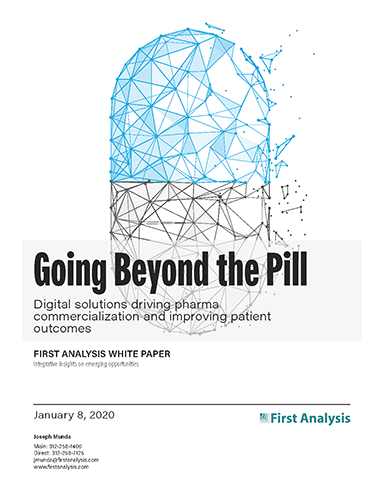White paper: Going beyond the pill
Digital solutions driving pharma commercialization and improving patient outcomes

Economic and regulatory pressures, pricing scrutiny, new industry stakeholders, and the explosion of real-world data have caused life sciences companies to rethink their commercialization strategies.
By leveraging data-driven digital technologies, life sciences companies can generate the knowledge and insights needed to improve commercialization and patient outcomes.
In this report, we explore the dynamic and rapidly evolving array of digital technology solutions related to the drug commercialization process, highlighting numerous promising opportunities in this burgeoning emerging sector
TABLE OF CONTENTS
Includes profiles of 134 public and private companies
- Pharma commercialization: Changing the way drugs are marketed
- The emergence of the CRM: Improving sales-force effectiveness
- Going beyond the CRM: Unifying databases through master data management systems
- Storing the data: Challenges pharma faces with data integration
- Data sources: Which data is useful and which data is acceptable for regulatory approval
- Analytics: Harnessing the power of real-world data to lower costs, recruit patients
- Emerging digital channels: Leveraging prescription data through virtual reality education
- Background on KOLs: How key opinion leaders are used to validate drugs
- Digital KOLs: Emergence of digital platforms to promote research and new products
- Patient centricity: Understanding the patient experience to improve outcomes
- Direct-to-consumer advertising: Another way for pharma to reach physicians
- Point-of-care advertising: Another way for pharma to reach patients
- mHealth: Using mobile and wireless devices to improve health outcomes
- Digital therapeutics: Software that aides in diagnosis, treatment, and coordination of care
- Medication adherence & compliance: Software that engages with patients to increase compliance
- Patient communities & social media: Where patients can share information and receive advice
- Hub services: Where patients and HCPs go for benefit verification and prior authorization of specialty drugs
- Engaging payers: The emergence of outcomes-based payment models
- Company profiles
Data is the new gold
The life sciences industry is experiencing a great transformation in customer and market dynamics. The emergence of specialty segments, increased regulatory constraints, the focus on subgroups in various therapeutic areas, and a recent explosion of information have all added to the complexity of the industry, while drug pricing regularly makes the headlines, with patient advocacy organizations, healthcare providers (HCPs), and politicians weighing in on the discussion. With years of painstaking R&D and new drugs costing pharmaceutical companies hundreds of millions to billions of dollars, the entire business model of pharmaceutical companies hinges on their ability to monetize the drugs they develop and bring to market. The increased focus on cost from stakeholders has prompted the life sciences industry to demonstrate value with supporting data.
In one form or another, the topic of data has rippled through the life sciences industry for years. At first, it was the term ‘big data’ that attracted the attention of industry executives. Now, real-world data (RWD) and real-world evidence (RWE) are front and center. While RWD and RWE are often used interchangeably, the U.S. Food and Drug Administration (FDA) provides a distinction. It defines RWD as data collected from sources outside of traditional clinical trials. RWE is generated through the analysis and/or synthesis of RWD to identify the effects of health interventions, such as benefits, risks, or resource uses that are not collected during a clinical trial. What unites these concepts are digital technologies. Digital technologies provide the ability to rapidly and easily collect, store, analyze, and transmit data on a large scale, unlocking huge potential in drug discovery, clinical development, commercialization, value-based care, and patient safety. Drug launch is no longer the finish line, but rather the beginning of the race.
The life sciences industry is swimming in data, from internally generated clinical data to outsourced vendor provided prescription data. This is partly the result of new digital technologies such as wearables, tablet computers used for engagement, and medical devices with built-in features that facilitate data collection, patient reported outcomes data, sales and marketing data, and other kinds of information. It’s also the result of digital platforms such as electronic medical records (EMRs) and CRM (customer relationship management) software that make the collection and analysis of data possible. As the hardware and software to manage large data sets continue to evolve, so too have the sources of data grown. Privately held databases, as well as public data provided by government agencies such as the Centers for Medicare & Medicaid Services (CMS), have become essential components of the clinical development and commercialization process. If data is the new gold and pharma companies are the new miners, then data collection/management tools and analytics are the new picks and shovels.

Request full report
To access the full report, please provide your contact information in the form below. Thank you for your interest in First Analysis research.
